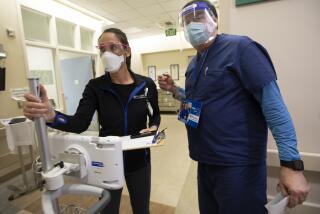INFECTIOUS DISEASE REPORT
- Share via
Each week the Orange County Public Health Department reports to the state the incidence of various infectious diseases in the county. The following table details a selection of these afflictions.
NUMBER OF CASES October Current Previous Year to Date 1988 Year Year % Change, Disease to Date to Date 87-88 Acquired Immune 11 223 197 +13 Deficiency Syndrome (AIDS) Campylobacter 17 244 300 -19 Lapse of consciousness 111 1,360 1,339 +2 (non-alcohol related) Giardiasis 46 361 375 -4 Gonococcal infection 225 2,323 3,036 -23 Gonococcal infection, PPNG 13 74 54 +37 Hepatitis A 71 321 274 +17 Hepatitis B 13 276 495 -44 Salmonellosis 26 293 323 -9 Shigellosis 79 356 210 +70 Streptococcal infection 223 3,111 1,996 +56 Syphilis 98 1,033 748 +38 Tuberculosis 29 193 240 -20
Acquired immune deficiency syndrome : Fatal disease that attacks the body’s immune system. Is caused by the human immunodeficiency virus. Transmitted by sexual contact, exposure to contaminated blood and from an infected mother to her new born.
Campylobacter: Characterized by sudden, acute diarrhea, abdominal pain, fever and vomiting. Associated with foods poorly refrigerated or improperly cooked, unpasteurized milk and unchlorinated water.
Giardiasis: A protozoan infection principally of the upper small intestine. May be associated with a variety of intestinal symptoms such as chronic diarrhea, abdominal cramps and bloating, fatigue and weight loss. Contracted by ingesting contaminated food or water.
Gonococcal infections: Sexually transmitted bacterial diseases that differ in males and females in terms of course, severity and recognition. PPNG, or Penicillinase-Producing Neisseria Gonorrhoeae, are strains resistant to penicillin.
Hepatitis A: An acute viral illness affecting the liver. Occurs mostly in children and young adults. Usually transmitted by oral ingestion of infected material or by poor sanitation.
Hepatitis B: An acute illness of the liver transmitted by exposure to contaminated needles, by administration of blood or blood products and/or oral ingestion of contaminated material.
Salmonellosis: A bacterial disease characterized by the sudden onset of a headache, abdominal pain, diarrhea, nausea, vomiting, dehydration and fever. Contracted by eating contaminated food.
Shigellosis: Acute diarrhea acquired by person-to-person contact, through eating contaminated food or by handling contaminated objects.
Streptococcal infection: Often manifested as strep throat or scarlet fever. A sphere-shaped bacteria that grows like chains of little balls.
Syphilis: A chronic venereal disease caused by a spirochete and transmitted by sexual intercourse. The first symptom, a chancre, appears after an incubation period of 12 to 30 days and is followed by a slight fever.
Tuberculosis: A mycobacterial disease that usually affects the lungs. General symptoms include sweats, hectic fever and severe weight loss.
Sources: Orange County Public Health Department, “Reported Cases of Specified Notifiable Diseases,” for July, 1988.
“Control of Communicable Diseases In Man,” an official report of the American Public Health Assn., Abram S. Benenson, editor, 1985, 4th edition.
“Better Homes and Gardens Family Medical Guide,” Donald G. Cooley, editor, 1973, 2nd edition.
“The Bantam Medical Dictionary,” prepared by Laurence Urdang Associates Ltd., 1982.
“Stedman’s Medical Dictionary,” Williams and Wilkins Co., 1973, 22nd edition.
More to Read
Sign up for Essential California
The most important California stories and recommendations in your inbox every morning.
You may occasionally receive promotional content from the Los Angeles Times.












